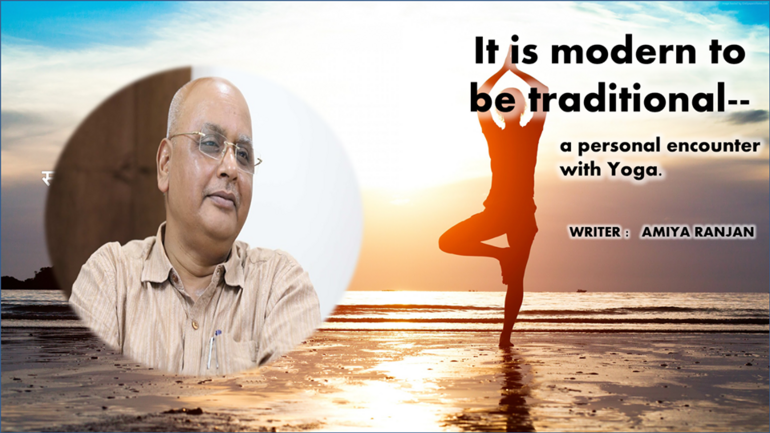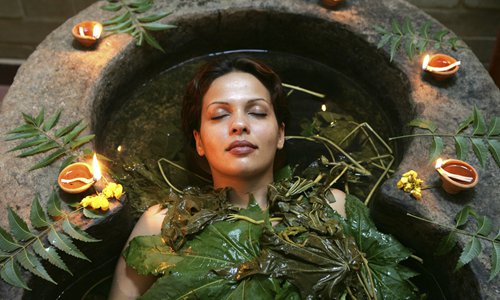My Experience With Yoga
My experience with Yoga dates back almost 35-40 years. At that point in time “Yog” was still “Yog” and not YOGA. We had a saffron-clad “Swamiji” who would lovingly teach us a “new” style of exercise that was supposed to heal both mind and body. We had been ordered by our father that we had to attend the classes daily so we had to. That was the time when these orders were not questioned and there was no reasoning attached to it.
These days parents are hard-pressed to explain to children why this and not that. Does everything need logic these days? If it is not explained by science then it is mythical or hearsay at least defies my understanding. There are so many things still unexplored and unexplained despite so much progress in science and other subjects. This brings me to a very interesting fact, we in India are very good at deriding our own traditions and belongings. We find everything the other person shows as glitterier.
Likewise, for culture, practices, development and the list go on. Maybe this was one of the reasons why the Indian sub-continent has seen so many invaders in the past. No comments on the impact but we have lost a good part of our heritage. Yog was like that, when we started doing Yoga was alien to people who had started doing weight training, calisthenics, Aerobic and anaerobic exercise. In the name of the exercise, sports were making heavy inroads in the form of cricket, badminton, football, etc.
After Almost A Year Of Practice
After almost a year of practice and we were taken to schools and colleges to give Yog demonstrations. We were young and pliable and would almost adapt to the intricacies of fish taking to water.
One aspect that I still remember was that there was a group of people who had come from Israel to learn Yoga and that was almost 40 years back. They would practice along with us. Now in retrospect, I realize how early they had realized the importance of Yoga for healthy living. It was not the stamp of approval from NASA that Yog was the best form of exercise for a healthy body.
My love-hate relations with Yoga went on for years with long periods of almost not doing any exercise and gaining weight and with it all the accompanying princely diseases. The only part was that I did not leave Yoga completely and would practice “whenever I would get time”. Whenever is cliched as you must have realized that it is more a matter of pretension of not getting time rather than actually not getting time.
Circa 2020 is a complete circle and I have become a staunch and avid practitioner of Yoga. This is the only way one can remain healthy without taking the help of any medical practitioner. The old wisdom that your medicines in life is in your kitchen stands true. We are so overwhelmed by the Allopathic way of drug practice and diagnosis that we have almost forgotten the traditional wisdom given by our ancestors.
Main Topic Of Health And yoga
I may have wandered astray from the main topic of Health and yoga, but one needs to understand and love Yoga to be able to practice it as a part of healthy living. It should not be treated in isolation but should form a way of life.
I am quoting verbatim the write-up on Yoga from Wikipedia
“Yoga (/ˈjoʊɡə/;[1] Sanskrit: योग; (pronunciation) is a group of physical, mental, and spiritual practices or disciplines which originated in ancient India. Yogis is one of the six Āstika (orthodox) schools of Hindu philosophical traditions.
There is a broad variety of yoga schools, practices, and goals in Hinduism, Buddhism, and Jainism. The term “Yoga” in the Western world often denotes a modern form of hatha yoga and yoga as exercise, consisting largely of postures or asanas.
The practice of yoga has been thought to date back to pre-Vedic Indian traditions; possibly in the Indus valley civilization around 3000 BCE. Yoga is mentioned in the Rigveda and also referenced in the Upanishads, Although, yoga most likely developed as a systematic study around the 5th and 6th centuries BCE, in ancient India’s ascetic and śramaṇa movements. The chronology of earliest texts describing yoga practices is unclear, varyingly credited to the Upanishads. The Yog Sutras of Patanjali date from the 2nd century BCE, and gained prominence in the west in the 20th century after being first introduced by Swami Vivekananda. Hatha yog texts began to emerge sometime between the 9th and 11th centuries with origins in tantra.
Yog Gurus From India
Yoga gurus from India later introduced yoga to the West, following the success of Swami Vivekananda in the late 19th and early 20th century with his adaptation of yoga tradition, excluding asanas. Outside India, it has developed into a posture-based physical fitness, stress-relief, and relaxation technique. Yog in Indian traditions, however, is more than physical exercise; it has a meditative and spiritual core. One of the six major orthodox schools of Hinduism is also called Yoga, which has its own epistemology, ontology, and metaphysics, and is closely related to Hindu Samkhya philosophy.”
I have deliberately given this extract to give an insight into the transformation that Yog has undergone. The extract “Yoga in Indian traditions, however, is more than physical exercise; it has a meditative and spiritual core. I subscribe to this aspect of Yog practice and would encourage more Indians to practice Yoga. Not for the reason of a healthy body but a healthy mind and a healthy outlook towards society. This would lead people to love what they have, appreciate and rejoice in their culture, tradition, and way of life. Instead of aping others and an unhealthy rat race leading them to nowhere. ( written by : Amiya Ranjan)
[Amiya Ranjan (1967- ) is a freelancer with a penchant for incisive exploration into the world and the affairs around him.]
ranjan_amiya@yahoo.com
***




